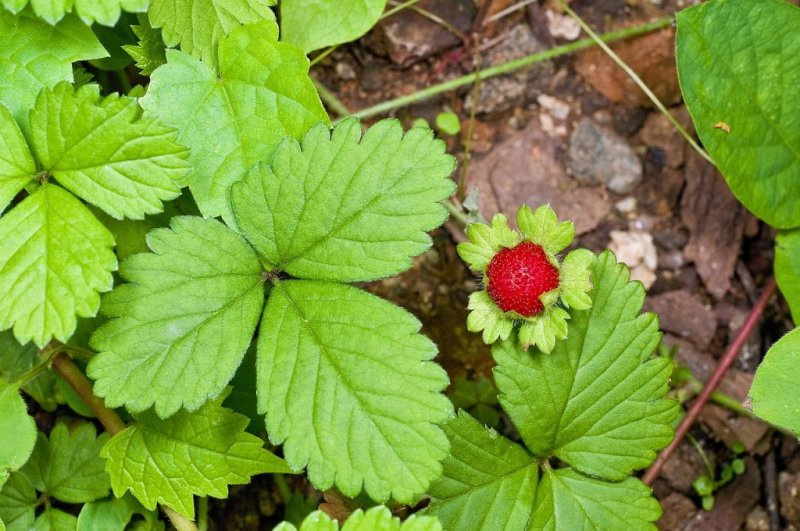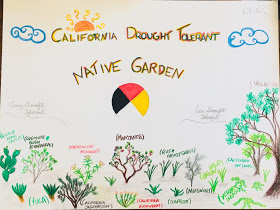
This project is for everyone to use, whoever is interested in the conservation and use of these amazing plants, please feel free to follow this drawing and research as an inspiration to create and grow your own garden, medicine and food. The plants are positioned with some of their usual companions in the wild, and the most drought tolerant ones are on the left. The research starts on the right, with the oak, and is about their uses and characteristics.
I dedicate this to the Ohlone people of the Bay Area, may all their relations and themselves have space and thrive in their home, may we once again respect and live in tune with the land.
Thank you to the Bay Area Farmer Training, Sogorea te Land Trust, Planting Justice, MESA (Multinational Exchange for Sustainable Agriculture) and all the amazing people who are a part if it for all the support and learning, I am forever grateful.
**How it was done: **
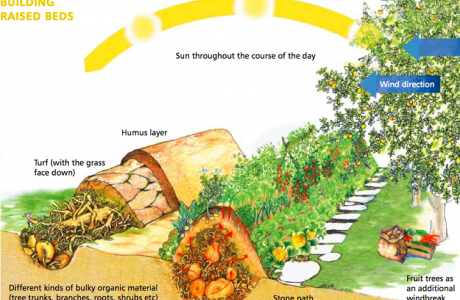
The site where this project was first done is located at the Sogorea te Land Trust at the Planting Justice Nursery in East Oakland. We made a bed for the plants utilizing the Hugelkutur method, this is a very simple method, that is very good for saving water. To make a hugel bed, you mound logs, branches, leaves, grass clippings, straw, cardboard… or other biomass you have available, top this woody mound with soil and compost and it’s ready to plant the natives, we also added plenty of wood chips to the top of the mound, so we can save more water and foster mushrooms.
To find out more about Hugelkutur you can read this article at the Permaculture Magazine, or look for more information on the internet. https://www.permaculture.co.uk/articles/many-benefits-hugelkultur
From the very beginning to 8 months later:
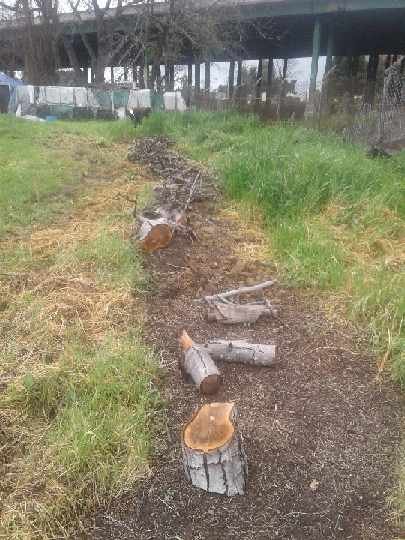
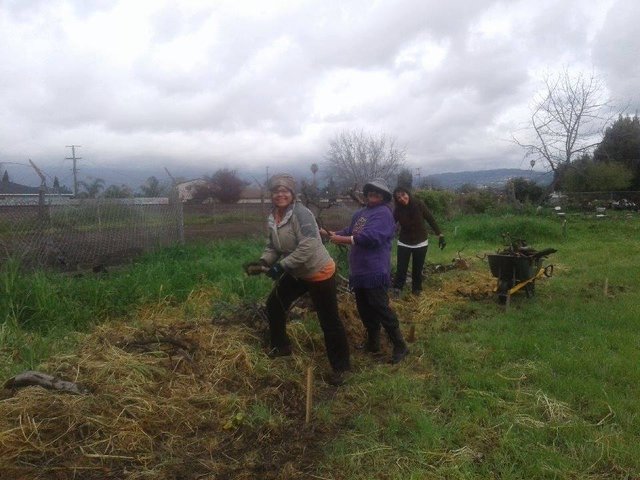
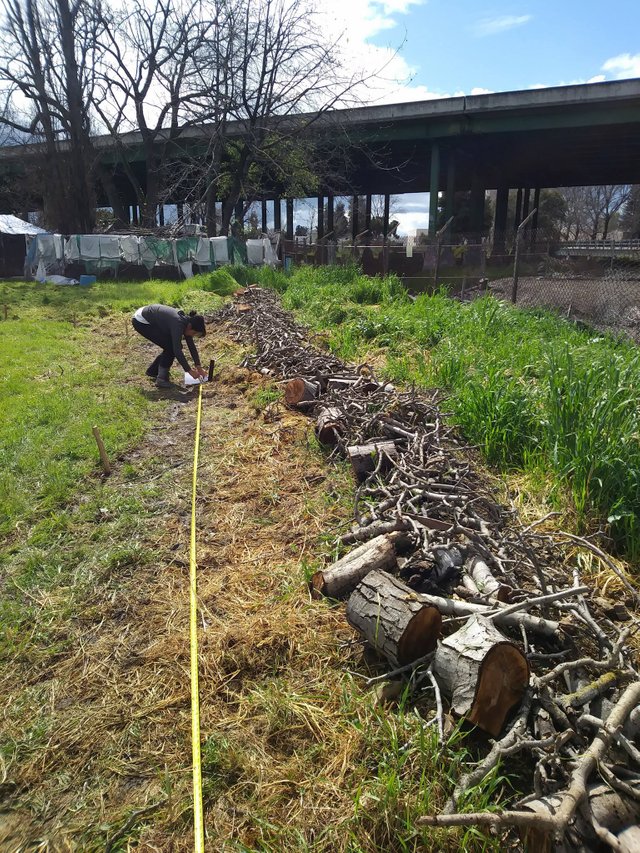
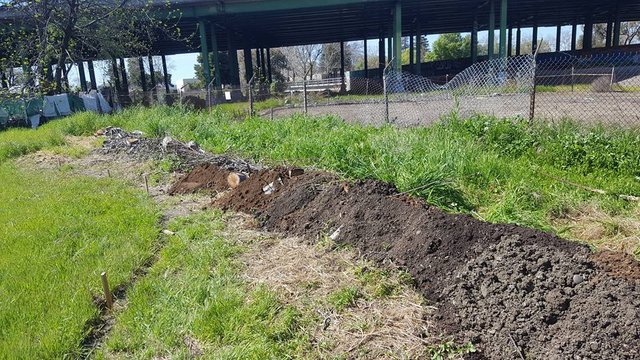
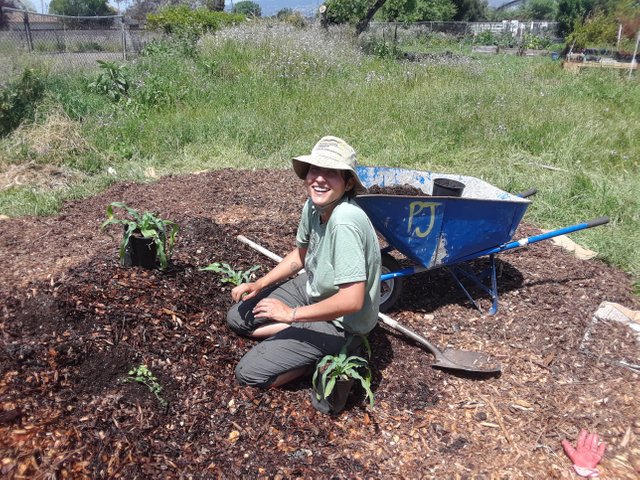
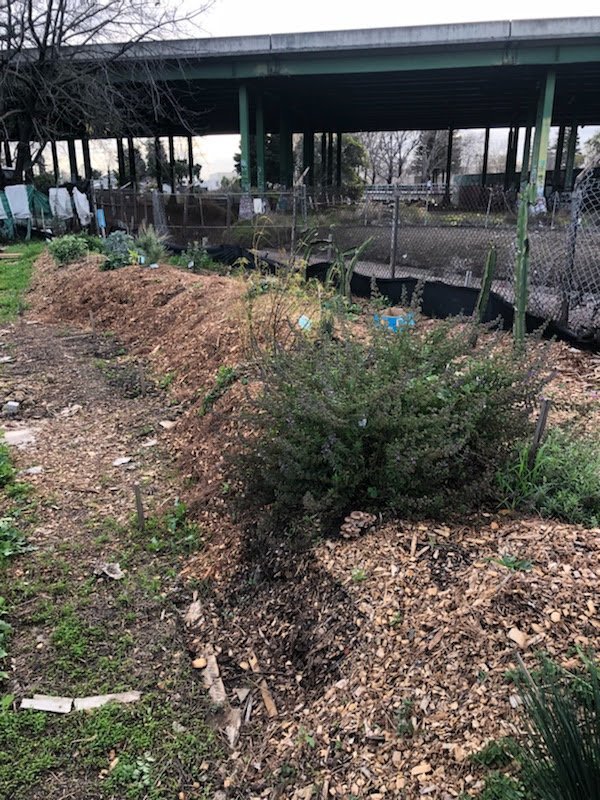
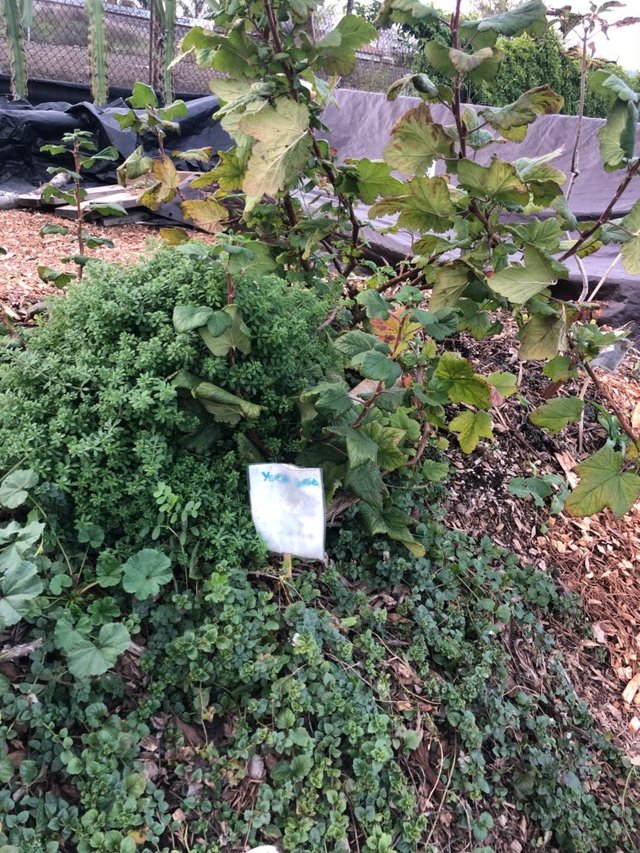
Oak
Valley oaks are the best choice in our region for the harvesting of acorns, since they often produce copious amounts of large and easy to leach acorns, but you can gather from any type.
How to use: Acorns are the nuts of Oaks and after a process of leaching (leaving them in running water to remove the tannins that are toxic to us), they are good for human consumption, acorn flour is a good source of nutrients and was the main staple for the natives.
As well as using acorns for food, the oak tree has many other uses.
In Biodynamic gardening, you can use the oak bark to make a tea to spray your plants against mold and chewing insects. And the leaves that fall in the fall are great for making rich compost piles.
How to process acorns: the first step is shelling, which means cracking the acorns on top of a hard surface with a rock or mortar and pestle. Discard the shell and acorns that are not good and grind the nutmeat into a smooth pulp in a food processor, Vitamix, hand-cranked flour grinder… Then it is time to leach, place your ground up acorns in a bandana, pillow case… or several layers of cheesecloth, tie it up and put in running water, the ideal running water would be a spring or river, but if that`s not possible you can hang it on a garden tap on a slow drip, so you water your plants at the same time, or whatever you can come up to save water, like leaving it on slow drip on a sink tap with a bucket underneath so you can water your plants or flush with that. The leeching can take up to two weeks depending on the type of acorns you are using. You will know when you are finished when you taste and it is no longer bitter or strongly astringent. Squeeze the water out of it. You can use the wet acorn meal as soon as done, or dry it and store it for later or put it in the freezer.
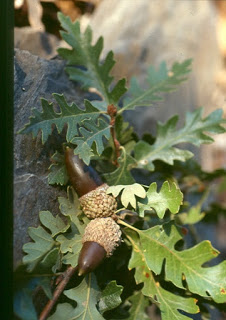
Yerba Buena
How to use: eat the leaves or make it into a tea for colds, flus, upset stomach, asthma and other respiratory problems. It has a delicious minty taste and it has been used for generations unknown, wonderful for aromatherapy and medicine making, I wish there were essential oils of this plant.
Yerba Buena is currently a threatened specie due to modern development and invasive grasses. It was so abundant in the bay that when the first spanish colonizers arrived they were stepping on fields of it, so they named what is now San Francisco, Yerba Buena. This plant is a wonderful ground cover (wouldn`t it be so wonderful and aromatic if instead of fields of grass we would be stepping on fields of Yerba Buena?), it typically grows on partly shady hilly woodlands under oak, bay trees and even coyote bush.
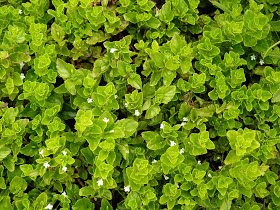
California Bay Laurel
How to use: This tree can be used all year, it`s leaves are very medicinal and strong, it can be used as a spice or in teas. Be aware it is very strong so a piece of the leaf is enough for a cup of tea. It is very antibiotic, good for healing wounds and headaches. The flowers happen late summer into fall, they are edible, but also have to be taken in low quantities. Fruits and nuts late October through early December.
Bay nuts are a real delicacy, they have properties very similar to the cacao and coffee; they can be eaten after the fruit has been removed and properly roasted. Since they have strong oils like cacao and coffee, you have to make sure they have roasted long enough before being able to have a full flavorful taste.
To roast the nuts: Peel the fruits. Wash the nuts - remove any excess goop. Dry the nuts. To dry, lay them out to open air until the water evaporates then store in paper bags or other breathable containers (an open bowl or jar) in the dark. Roast the nuts on a baking sheet in a single layer at 350 degrees F. This usually takes about 1 to 1.5 hours, but you’ll know they’re done when the insides look brown/black (some will crack open to reveal this), keep an eye on your nut, they have to be roasted all the way through. Crack open the shells with a nut cracker (teeth also work, but everyone cringes when I do that) and eat the nuts as you choose. They have a slightly bitter taste, but for those that like super dark chocolate, it’s delicious. Note that bay nuts possess a mildly stimulating effect, similar to caffeine, good to make them into powder, sweets...
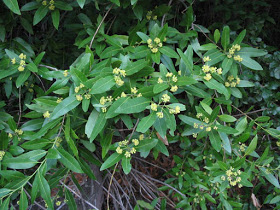
Wild Onion Lily
How to use: You can eat the whole plant, just like chives, and they taste very similar, but I prefer wild onion. Wild onion is great in pestos, salads, soups… everything that calls for onion or garlic really. It is antibiotic, anti inflammatory, good against colds and flus, similar properties to onion and garlic.
The best time time to harvest is beginning of spring. They are plants that go dormant in summer time, and they tolerate clay soil really well.
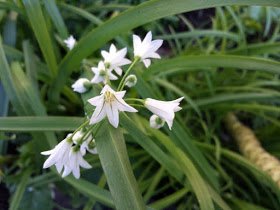
**California Mugwort **
How to use: Mugwort (Artemisia douglasiana) leaves can be used in tea, good for detoxifying, anti-parasitic and antiseptic, it`s a very medicinal herb, held sacred by many cultures. Can also induce vivid dreaming. Mugwort was very used to make beer, instead of hops you can use Mugwort, which will add a different medicinal value for the beer.
California Mugwort, Artemisia douglasiana, is a perennial that typically grows on stream banks, ditch banks, road cuts or other disturbed areas, it tolerates shade.
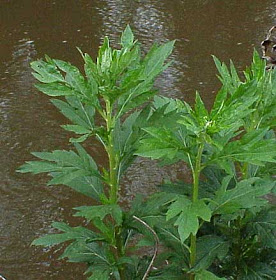
Soaproot
How to use: The root of this plant can be used as soap, it naturally produces saponins when in contact with water, the outer layer of the bulb can be used as a brush, or to make paint brushes. It is also edible when roasted for a long period of time in low fire, best to do it on the ashes of a campfire, it tastes like a sweet potato, just leave a little bit of the coating and let it roast until fully baked. The young green of the plant can also be eaten, since they are quite tough, it`s recommended frying them up in some butter and salt.
You can also use it for fishing! This plant is toxic to fishes and as such it can be used to paralyze the fishes in the water while you catch them for eating.
They are quite hardy plants, but grow very slowly, you usually find them in woodlands and along fire roads and trails in wilderness areas, usually out in the open space.
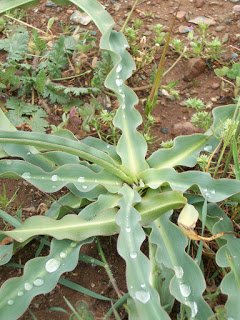
Rush Basket Grass
Juncus acutus and Juncus balticus are two species of rush that are from California. Rushes were used in making baskets for gathering food, leaching acorn meal, and many other things. They have a variety of colors gradients, allowing for the basket makers to use elaborate designs. It is also said to be a good plant against erosion.
They are very hardy plants that can adapt to different kind of soils, typically growing on sand dunes and salt marshes.
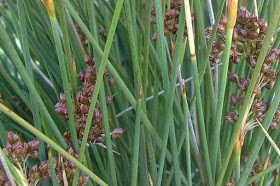
Manzanita
How to use: For poison oak rashes, steep manzanita leaves with water on the stove, drink and apply the tea to the rash. Also really good tea for stomach flu, you can also chew on a few leaves in case of dehydration. For burns, burn the leaves and gather the ashes, add water, making into a paste and apply on the burn, making into a bandage around your arm. The fruits are edible and sweet, really good if made into a cider, full of nutrients and vitamins.
To make a cider you can use the fresh berries, steeping them in water for a while, just leave them in the sun or in low heat for 30 min to 1 hour (if you are using the sun can be more), strain the infusion, since the berries have hard seeds in them, add some honey if you`d like and enjoy it. You can also dry the berries, powder them in a coffee grinder and use it for smoothies and baking.
Manzanita attracts a diversity of wildlife, such as Hummingbirds and Bumblebees. It likes full sun and usually grows on rocky soil and on hills and mountains.
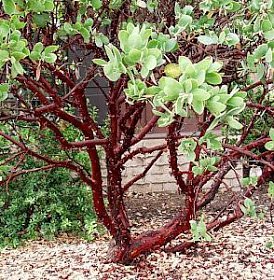
California Buckwheat
How to use it: Seeds and young shoots are edible. The flowers can be made in to a tea as an eye wash or laxative, good for headaches and stomach ailments. The seeds are harvested from June to September. And the shoots from February to May. It blooms all year.
Tipically is found in washes and canyons, and on dry slopes and meadows.
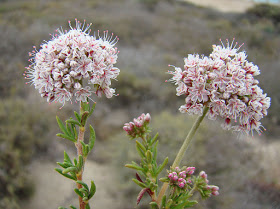.jpg)
Milkweed
California's narrow-leaved Milkweed (Asclepias fascicularis) is a perennial. In our area, this plant is covered with monarch caterpillars during the summer. The Orioles use the dead stems for nests the next spring. It`s a very important plant for wildlife and the conservation of the Monarchs. The milk that saps when you brake the stem can be used on the skin for wart removal. The Karuks also made a a chewing gum out of the milk, by steeping it in hot water, becoming a gel.
Milkweeds are perennial, needs sun and can be quite drought tolerant, it can tolerate some pretty awful coastal clays that are sour bogs in winter and salty toast in summer.
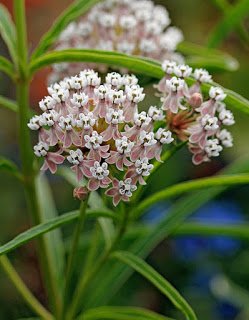
California Sagebrush
How to use: Leaves and flowers, make it into a tea for relieving menstruation pain, childbirth and postnatal recovery, colds and stomach ailments. It was very commonly used as a construction material for roofing and the wattling of walls made from cob and adobe. It was also laid out over perishable foods to help preserve them.
This plant is extremely drought tolerant, and will often be the only plant growing on the driest, south-facing slopes in the driest parts of it's range. It's tough and easy to grow, fast growing.
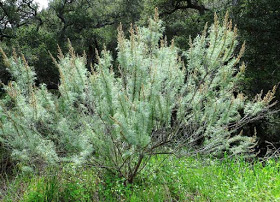
Yucca
How to use: The green fruit pods can be eaten raw, but it is better roasted. The leaves can be used whole for tying pole and beams. The fiber of the leaves can be used to make baskets, paint brushes, mats, netting, sandals, bowstrings, strings and ropes. You can also use the root to make soap and the seeds for making necklaces… The large black seeds can also be made into a flour. The fruits with the skin removed can be consumed raw, or better when roasted, or pounded into a meal. The roots pounded in water produce a lather that serves as soap and is really amazing for the skin, specially if you have any skin condition.
It enjoys full sun and sandy soil.
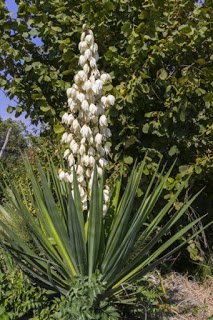
Creosote Bush (Chaparral)
How to use: This is a very strong plant, it has a high amount of oils and strong taste, it is a strong medicine. A decoction/tea of the leaves can be used as an antiseptic on sores and wounds and bathed in it as an aid for rheumatism, it`s really good for skin problems. The leaves can also be used as a treatment for upset stomachs, colds and veneral diseases. Its resins provided a glue used in arrow making and pottery mending. In Mexico, flower buds are eaten and pickled in vinegar. It is used as a food preservative.
Creosote bush is the most common desert shrub of California, it is very abundant on the Mojave desert.
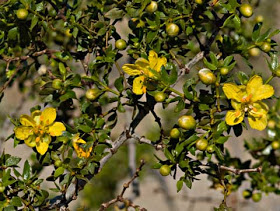
Prickly Pear Cactus
How to use: The broad leaves, called pads or nopales, produce pretty yellow to red flowers in spring, which in turn produce red to purple fruit in fall. Both the pads and fruits are edible, but both have tufts of spines protecting them. The spines can be long and large on the pads, but those on the fruit are usually extremely small but just as painful. Be extremely careful when harvesting the fruits, the spikes can even fly to your eyes, so you have to wear glasses when doing it, do not touch them in any situation, when harvesting use a fork to rub it on sand or ground as soon as you get it, but the easiest way of taking those nasty spines off, and you have to do it before you handle them, is simply roasting the fruit on a fire, it can be your stove, or fireplace, or a bonfire, barbecue, stick a fork and twirl them over the fire, making sure you got all the sides, peel the skin off and the amazing fruit is ready to be eaten! The fruit is the part of the cactus from which juice or wine can be made, it is super sweet and good, the seeds are hard but safe to injest, or you can spit them and save them to make dyes, they make a purple color.
To make prickly pear
8 quarts of cleaned prickly pear fruit pulp or cut not larger than one inch
4 quarts of water
Wine yeast
Slowly cook the fruit pulp and water for one to two hours after it begins to boil. Let cool enough to handle, strain and return the syrup to the fire for another hour, boiling slowly. Remove from heat and cool to 70 degrees F. Pour into the fermentation vessel and add wine yeast. Seal with air lock and allow to ferment for at least four days, or until fermentation is complete, bottle and store.
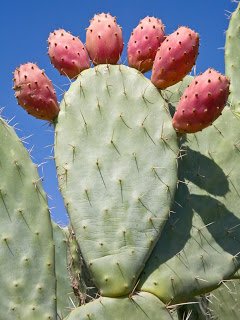
Wild/Wood Strawberry
How to use: As well as eating the little sweet fruits, the leaves are used for any type of mouth sore, like canker sore, gum boils or sore throat. You can eat chew on the fresh leaves or make a tea out of them. For sore throat gargle the tea after cooling it 2 to 3 times a day, until you feel better.
Wood Strawberry is a perennial and tolerates shade and clay soil. Fragaria californica, (F. vesca), Wood Strawberry makes a good ground cover for dry to damp shady areas or sunny areas with moderate water.
